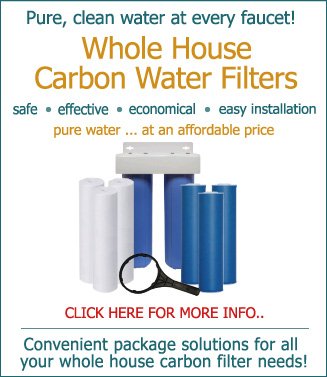Granular Activated Carbon (GAC) and Carbon Block Filters

Carbon is a substance that has a long history of being used to absorb impurities and is perhaps the most powerful absorbent known to man. One pound of carbon contains a surface area of roughly 125 acres and can absorb literally thousands of different chemicals. Activated carbon is carbon which has a slight electro-positive charge added to it, making it even more attractive to chemicals and impurities. As the water passes over the positively charged carbon surface, the negative ions of the contaminants are drawn to the surface of the carbon granules.
Activated carbon filters used for home water treatment typically contain either granular activated carbon (GAC) or powdered block carbon. Although both are effective, carbon block filters generally have a higher contaminant removal ratio. The two most important factors affecting the efficiency of activated carbon filtration are the amount of carbon in the unit and the amount of time the contaminant spends in contact with it. The more carbon the better. Similarly, the lower the flow rate of the water, the more time that the contaminants will be in contact with the carbon, and the more absorption that will take place. Particle size also affects removal rates.
Activated carbon filters are usually rated by the size of the particles they are able to remove, measured in microns, and generally range from 50 microns (least effective) down to 0.5 microns (most effective).
A typical counter-top or under-the-counter filter system has from 12 to 24 ounces of activated carbon. The most common carbon types used in water filtration are bituminous, wood, and coconut shell carbons. While coconut shell carbon typically costs 20% more than the others, it is generally regarded as the most effective of the three. All of our activated carbon filters use coconut shell carbon.
There are two principal mechanisms by which activated carbon removes contaminants from water; adsorption, and catalytic reduction, a process involving the attraction of negatively-charged contaminant ions to the positively-charged activated carbon. Organic compounds are removed by adsorption and residual disinfectants such as chlorine and chloramines are removed by catalytic reduction. |
Activated carbon filtration is very common in a number of home water treatment systems. It can be used as a standalone filter to reduce or eliminate bad tastes and odors, chlorine, and many organic contaminants in municipal (pre-treated or chlorinated) water supplies to produce a significantly improved drinking water. It is also very commonly used as a pre-treatment as part of a reverse osmosis system to reduce many organic contaminants, chlorine, and other items that could foul the reverse osmosis membrane. 0.5 micron carbon block filters are commonly used to remove cysts such as giardia and cryptosporidium. |
| What Contaminants Does Carbon (GAC) Remove? |
|---|
Activated carbon filters remove/reduce many volatile organic chemicals (VOC), pesticides and herbicides, as well as chlorine, benzene, trihalomethane (THM) compounds, radon, solvents, and hundreds of other man-made chemicals found in tap water. Some activated carbon filters are moderately effective at removing some, but not all, heavy metals. Catalytic carbon filters are effective at removing chloramine and hydrogen sulfide. In addition, densely compacted carbon block filters mechanically remove particles down to 0.5 micron, including Giardia and Cryptosporidium, turbidity, and particulates.
Carbon filters are NOT generally successful at removing dissolved inorganic contaminants or metals such as minerals/salts (hardness or scale-causing contaminants), antimony, arsenic, asbestos, barium, beryllium, cadmium, chromium, copper, fluoride, mercury, nickel, nitrates/nitrites, selenium, sulfate, thallium, and certain radio nuclides. Removing these contaminants requires either a reverse osmosis water filter system or a distiller (some can also be removed by KDF-55).
GAC does not remove sediment / particulate material very well, so they are often preceded by a sediment filter. Sediment pre-filters also prolong the activate carbon cartridge life by eliminating gross contaminants that would otherwise clog the activated carbon thereby reducing the surface area available for absorption. Carbon block filters are generally better than GAC filters at removing sediment.
| Arsenic | Bacteria and Viruses |
Bad Tastes & Odors |
Chlorine | Fluoride | Hydrogen Sulfide |
Heavy Metals |
Nitrates | Radon | Sediment | Iron | VOC's |
 |
 |
 |
 |
 |
 ** ** |
 |
 |
 |
 to to  |
 |
 |
 = Effectively Removes
= Effectively Removes  = Significantly Reduces
= Significantly Reduces  = Minimal or No Removal
= Minimal or No Removal
** At high contaminant levels, filter life will be significantly reduced. A whole house iron reduction filter is recommended for Hydrogen sulfide.
please CLICK HERE.
|
|
Virtually all of our home water purification systems include activated carbon filtration either as a primary filter or as a pre-filtration treatment. |
Activated carbon filters require very little maintenance, however, it is very important to ensure that filter replacement schedules are followed to ensure proper filtration at all times. Do not wait for bad tastes and odors to return to the water before deciding the filter needs replacement as this is an indication that the filter is no longer able to completely remove contaminants and that it has surpassed its service life. |
| Frequently Asked Questions About Activated Carbon Filtration |
|---|




